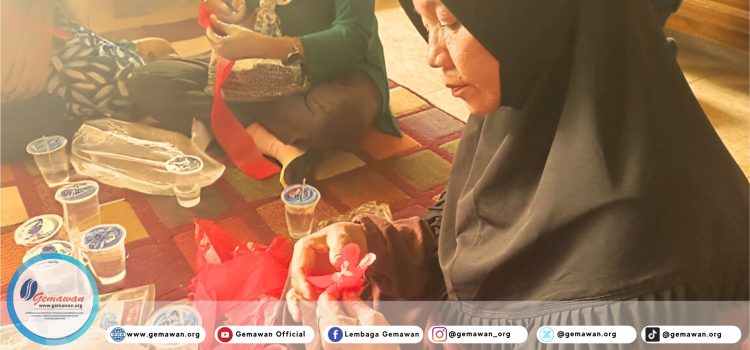
“Waste is our reflection. If we ignore it, it becomes a disaster.
But if we manage it, it becomes a blessing.”
— Serumpun Asoka Waste Bank Community
Turning Trash into Savings
In a narrow alley called Asoka Street, in Sungai Garam Hilir Subdistrict, Singkawang, a group of women and youth are transforming household waste into a source of hope.
They are the driving force behind the Serumpun Asoka Waste Bank, an initiative born from frustration over mounting garbage and a shared dream of empowering their community.
Back in 2015, residents began gathering under the name Serumpun Asoka for social activities. Three years later, after observing neighbors selling dry recyclables to informal collectors, the idea of a local waste bank emerged.
“Why don’t we manage it ourselves? Waste can become savings,”
recalled Wiwin Yuliana, the chairperson of the waste bank.
Their idea gained traction when the Singkawang Environmental Office (DLH) invited them to attend waste management training. Through collective effort, they secured legal recognition from the local government—and in 2018, Serumpun Asoka Waste Bank was officially established.
Behind the Piles of Cardboard and Plastic Bottles
On the first week of every month, members bustle in their small warehouse, sorting recyclable materials: cardboard, plastic bottles, cans, and paper. The waste comes from 58 active depositors, most of them nearby residents.
“We have to sort everything again before selling to the Central Waste Bank (BSI).
If not, the price is the same as what we pay to members—meaning no profit for us,”
explained U. Zulfia, one of the administrators.
Proceeds from sales are deposited into collective accounts. The highest savings recorded have reached Rp3 million, while most members save around Rp100,000.
“Before Eid, many withdraw their savings to buy holiday essentials,”
said Budhe Mujilah, smiling.
Beyond collecting, creativity thrives. Nurambia and Mami Julina transform plastic waste into stylish handbags, while used egg trays become decorative flowers. Unfortunately, their crafts only sell during exhibitions or environmental fairs.
“When there’s no event, our products pile up in storage.
We need a permanent market,”
Wiwin admitted.
Challenges Along the Way
Their journey is far from easy. Many locals still dismiss the idea that waste has value.
“A big sack only earns Rp3,000. Some say it’s better to just throw it away,”
said Budhe.
To change this mindset, they involve children in waste-saving activities.
“Even if they save just Rp2,000, they’re happy to buy snacks with their own money,”
she added.
A tricycle from DLH and the local government once boosted their operations, but high fuel and maintenance costs often leave it idle.
“We agreed on a 70–30 profit share with the driver. The most important thing is that the service keeps running, even with small profits,”
explained Alfy, a member of the empowerment team.
Stories of Hope and Humanity
Among their most inspiring stories is that of a young orphan, recently converted to Islam, who now works as a waste transporter.
“We empower him so he can earn a living while contributing to the environment,”
said Budhe.
“The collection is coordinated by our neighborhood leader, Mr. Zamhari, who ensures every household is served,”
she added.
There’s also Bu Nurambia and Mami Julina, dedicated housewives teaching others how to create upcycled crafts.
“From old plastic bags, she makes beautiful dresses—but it’s sad to see her creations piling up unsold,”
said Wiwin.
A Vision for a Cleaner Future
Currently, the Asoka Waste Bank operates in only 3 out of 12 neighborhoods in Sungai Garam Hilir. Their dream is simple: every neighborhood should have its own collection point.
“If all areas get involved, the impact will multiply,”
Wiwin said.
They hope for continued support from Gemawan and local authorities, particularly to improve product marketing.
“We need a glass display cabinet to protect our crafts from damage—but we’re embarrassed to keep asking for help,”
she added softly.
Transforming Waste, Transforming Lives
In this quiet corner of Singkawang, the Serumpun Asoka Waste Bank shines as a beacon of how waste can bring dignity, not despair. The impact reaches beyond cleaner streets—it transforms mindsets and livelihoods.
Their goal is clear: to reduce waste volume, keep the environment tidy, and turn trash into cash. Under the guidance of Anisah, members also learn to make organic fertilizer from household waste, while recyclables like bottles and cans become savings or art pieces.
The waste tricycle (tossa)—a product of collaboration between the community, DLH, and the local government—operates regularly, collecting unmanaged waste from house to house.
For the women of Asoka, waste is no longer an enemy but a lifeline. Each bottle or scrap of paper becomes a small safety net.
“When my child had a high fever, I used my waste savings to buy medicine,”
shared Mama Cahyani, a member whose total savings reach Rp3 million collectively.
What may seem small to others means everything to them—a sign that waste can save lives.
Beyond economics, the waste bank has also opened doors for marginalized youth. The once jobless orphan driver now earns a living and finds pride in serving his community.
“I’m proud to help clean the neighborhood while earning an income,”
he said.
Even children are part of the movement—learning early that every Rp2,000 saved from waste matters, and that caring for the earth begins at home.
Meanwhile, recycled crafts—like plastic handbags and egg-tray flowers—stand as quiet acts of resistance against a throwaway culture.
“Every time someone buys one of my bags, I feel my effort wasn’t in vain,”
said Bu Nurambia.
Their work, though humble, continues to spark conversations about sustainability and community resilience—in schools, local meetings, and homes across Singkawang.
Writer: Wanti A., Gemawan Activist
